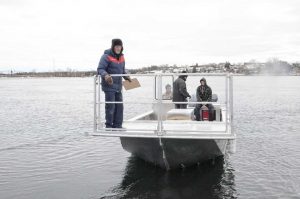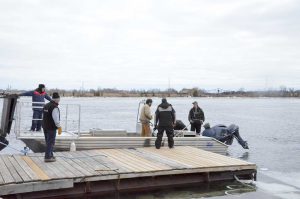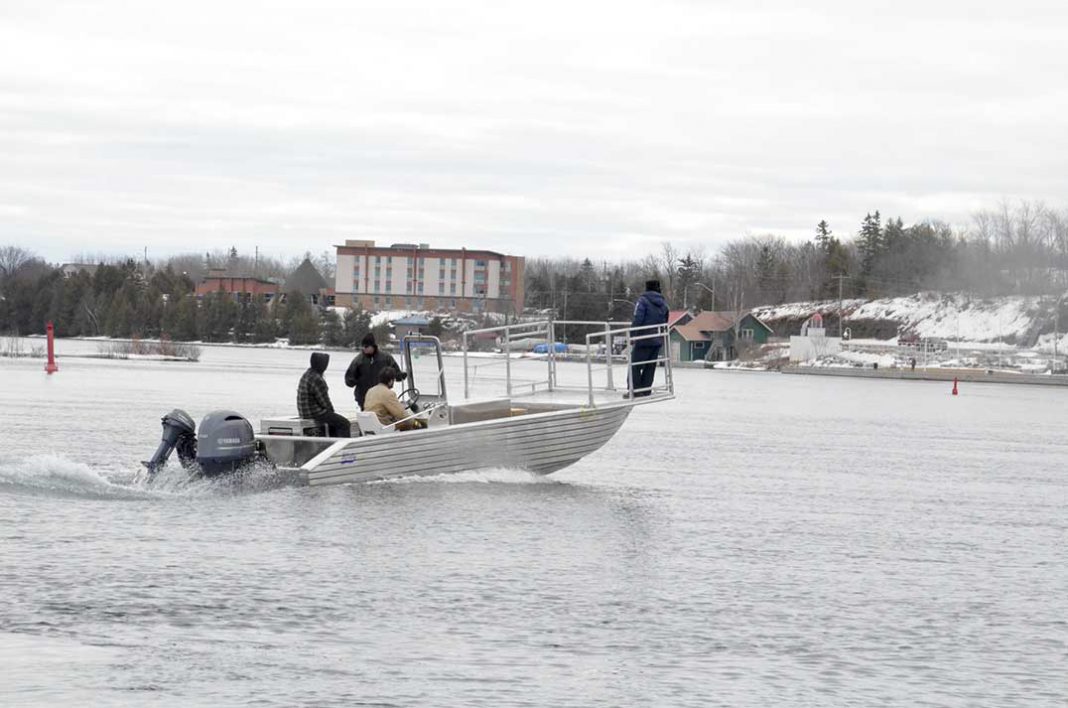LITTLE CURRENT—The design crew from Henley Boats of Manitowaning were back at Boyle Marine in the Port of Little Current this past week as they took one of their latest creations out into the ice-free waters for a hefty series of waterborne tests. This latest 25-foot vessel sports a shallow draft and a large work platform on its bow and is destined for the Canadian Department of Fisheries and Oceans (DFO), where it will be at the forefront of the battle against invasive species—specifically the Asian carp.
David Marson, senior aquatic biologist with DFO was on hand to oversee the tests of the new electro-fishing vessel.
“This will be the third vessel we have sourced from Henley Boats,” he noted. “It’s great to be able to buy Canadian product.”
Not only is the base vessel Canadian designed and built right here on Manitoulin, but the electronics and mechanical boom for the nets will be installed at a company in Guelph, he explained.
Once it is fully outfitted and checked over, the new electro-fishing vessel will be patrolling the waterways that abut where the US waterways that have been infiltrated by the Asian carp connect the Canadian Great Lakes. An electro-magnetic field “herds” fish to the front of the vessel, where the fish are stunned, floating to the surface to awaiting nets to be moved into a waiting livewell in the centre of the vessel. The fish are then sorted, with invasive species bound for cold storage at the Royal Ontario Museum (ROM) and native species returned to their home waters largely unharmed.
“We don’t have the facilities to hold the fish at DFO, but being able to store them at the ROM allows us to keep a timeline,” said Mr. Marson.
There are four species that make up the so-called Asian carp family: the bighead carp, black carp, grass carp and silver carp.

adjustments are complete at Henley Boats, the vessel will head down to Guelph, where another
Canadian company will install the electronics and other specialized equipment vital to its mission.
According to DFO, “To date, there have been a few rare captures of individual bighead carp and grass carp in the Canadian waters of the Great Lakes. Of the bighead carp, only three specimens have been collected, all in western Lake Erie, between 2000 and 2003, and are believed to have been intentionally released. Of the grass carp specimens, there have been approximately 23 single captures since 2012 in the waters or tributaries of Lake Huron, Lake Ontario and Lake Erie (the most recent in Lake Erie in 2016). Of those tested nine were found to be diploid, or fertile. It is likely that the fish caught were escapees from areas where populations were being used for aquatic plant control, or live releases. No silver carp or black carp have been found in the Great Lakes.”
Fisherman are urged to assist with efforts to track any sightings of Asian carp and report them to DFO. Do not return the species to the water. Specifically, the public is urged to “note the exact location (GPS coordinates) and the observation date; take photos; take note of identifying features; report an aquatic invasive species, and educate yourself on what you can do to reduce the risk.”
“We used to work from really small aluminum boats,” said Mr. Marson. The DFO work often requires close inshore work in shallow water. “The shallow draft on these Henley boats allow us to work in very shallow water, but they have a lot of room that makes moving around in them a lot more pleasant. Now that I have worked in one of these, I wouldn’t want to go back to the smaller boats.”

The Henley electro-fishing vessel not only has a shallow draft, but its strake creased hull and solid construction make it a very rugged workboat—and the powerful 150 hp Yamaha engine propels the vessel from site to site at a staggering speed. Trials have seen the vessel cruise at nearly 40 mph, and that wasn’t wide open.
The waters of the North Channel at the Port of Little Current have proven very useful to Henley Boats in recent years. Due to the strong currents found along the water
front, the North Channel remains largely ice-free, although there were plenty of random ice floes for the vessel to dodge as it made its way around the channel.
On the downside, it can be a pretty tricky operation to jockey the tested vessels back onto the cradles on their trailers for the trip back to the shop. Luckily, Henley Boats has an experienced crew on hand to handle the job.



